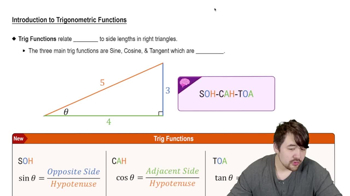Table of contents
- 0. Functions7h 52m
- Introduction to Functions16m
- Piecewise Functions10m
- Properties of Functions9m
- Common Functions1h 8m
- Transformations5m
- Combining Functions27m
- Exponent rules32m
- Exponential Functions28m
- Logarithmic Functions24m
- Properties of Logarithms34m
- Exponential & Logarithmic Equations35m
- Introduction to Trigonometric Functions38m
- Graphs of Trigonometric Functions44m
- Trigonometric Identities47m
- Inverse Trigonometric Functions48m
- 1. Limits and Continuity2h 2m
- 2. Intro to Derivatives1h 33m
- 3. Techniques of Differentiation3h 18m
- 4. Applications of Derivatives2h 38m
- 5. Graphical Applications of Derivatives6h 2m
- 6. Derivatives of Inverse, Exponential, & Logarithmic Functions2h 37m
- 7. Antiderivatives & Indefinite Integrals1h 26m
- 8. Definite Integrals4h 44m
- 9. Graphical Applications of Integrals2h 27m
- 10. Physics Applications of Integrals 2h 22m
3. Techniques of Differentiation
Derivatives of Trig Functions
Problem 3.5.33
Textbook Question
23–51. Calculating derivatives Find the derivative of the following functions.
y = cos² x
 Verified step by step guidance
Verified step by step guidance1
Step 1: Recognize that the function y = \( \cos^2 x \) can be rewritten using the identity \( y = (\cos x)^2 \).
Step 2: Apply the chain rule for differentiation, which states that if you have a composite function \( y = (u(x))^n \), then the derivative \( \frac{dy}{dx} = n(u(x))^{n-1} \cdot \frac{du}{dx} \).
Step 3: Identify \( u(x) = \cos x \) and \( n = 2 \) in the function \( y = (\cos x)^2 \).
Step 4: Differentiate \( u(x) = \cos x \) to find \( \frac{du}{dx} = -\sin x \).
Step 5: Substitute \( u(x) \), \( n \), and \( \frac{du}{dx} \) into the chain rule formula to find the derivative: \( \frac{dy}{dx} = 2(\cos x)^{2-1} \cdot (-\sin x) \).
 Verified video answer for a similar problem:
Verified video answer for a similar problem:This video solution was recommended by our tutors as helpful for the problem above
Video duration:
2mPlay a video:
Was this helpful?
Key Concepts
Here are the essential concepts you must grasp in order to answer the question correctly.
Derivatives
A derivative represents the rate of change of a function with respect to its variable. It is a fundamental concept in calculus that allows us to determine how a function behaves at any given point. The derivative can be interpreted as the slope of the tangent line to the curve of the function at a specific point.
Recommended video:

Derivatives
Chain Rule
The chain rule is a formula for computing the derivative of the composition of two or more functions. It states that if you have a function that is the composition of two functions, the derivative can be found by multiplying the derivative of the outer function by the derivative of the inner function. This is particularly useful when differentiating functions like y = cos²(x), where one function is nested within another.
Recommended video:

Intro to the Chain Rule
Trigonometric Functions
Trigonometric functions, such as sine, cosine, and tangent, are fundamental functions in mathematics that relate angles to side lengths in right triangles. In calculus, these functions have specific derivatives that are essential for solving problems involving rates of change. For example, the derivative of cos(x) is -sin(x), which is crucial when differentiating functions involving cosine.
Recommended video:

Introduction to Trigonometric Functions

 3:53m
3:53mWatch next
Master Derivatives of Sine & Cosine with a bite sized video explanation from Callie
Start learning




